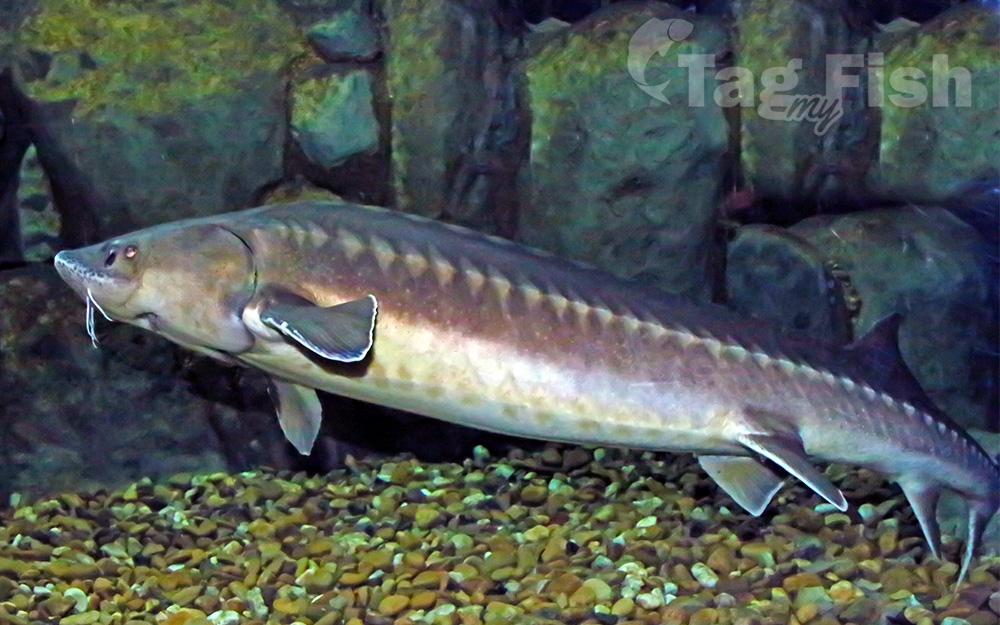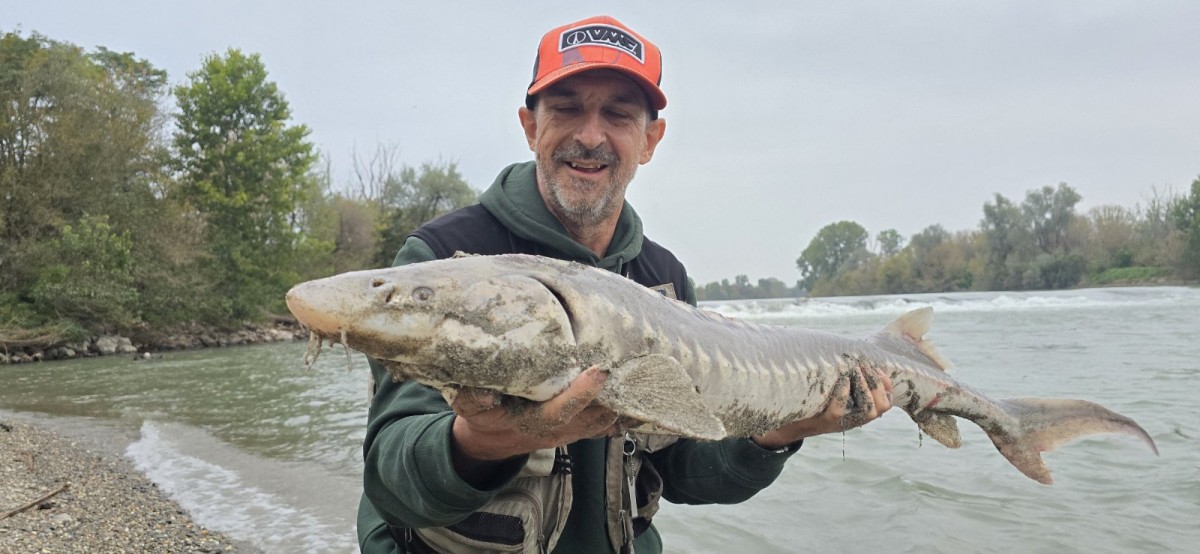Adriatic sturgeon
(Acipenser naccarii)

Classification
The Adriatic sturgeon (Acipenser naccarii) is a species of fish in the family Acipenseridae. It is native to the Adriatic Sea and large rivers which flow in it of Albania, Greece, Montenegro, Bosnia and Hercegovina, Croatia, and Italy. Specimens can be seen in several public aquariums, such as the Milan Aquarium, Aquarium Finisterrae, Aquarium of the Po, and Oasis of Sant\\\\\\\\\\\\\\\\\\\\\\\\\\\\\\\'Alessio in Lombardy.
Description
The Adriatic sturgeon reaches a maximum length exceeding 2 m (6.6 ft); the published maximum weight was 25 kg (55 lb), but large wild fish recently caught were evidently exceeding 40 kg (88 lb).
Like other surgeons, it has an elongated body, heterocercal tail, partially cartilaginous skeleton, naked skin and longitudinal series of bony scutes on the body. The rostrum is tendentially conical and rather short (1/3 of the head), the head is broad and rounded at the apex, with a protractile mouth whose lower lip is thin with a central cleft, and four barbels (circular section) which are closer to the tip of the snout than they are to the mouth. The series of longitudinal scutes are five: dorsal (1 series, 10–14 scutes), lateral (2 series, one per side, 30–42 scutes each) and ventral series (2 series, one per side, 8–11 scutes each). The dorsal fin has no spines and 36 to 48 soft rays, and the anal fin has 24 to 31 soft rays. The dorsal colouring is olive-brown, the flanks are paler and the underside white. Juveniles have a flattened and triangular rostrum, with a distinctive colouring on the back, dark brown with wide paler areas casually distributed.
Adriatic sturgeon was reported as very similar to the critically endangered European sea sturgeon (Acipenser sturio), once simpatric in the Adriatic sea, but distinctive characters for A. naccarii are:
- shorter and stocky snout;
- darker back, brown;
- less and lesser scutes in the lateral series;
- larger mouth;
- barbels closer to the tip of the snout (in A. sturio they are closer to the mouth);
- the mouth ends just after the front end of the operculum (in A. sturio it ends in the middle of the operculum);
- smaller dimensions.
Distribution
The Adriatic sturgeon can be found in freshwater and marine environments, including estuaries and brackish water. Historically it was to be found in the Adriatic Sea and the rivers flowing into it on either side. In 1932 its range in the sea was reported to be from Venice and Trieste to Greece and Corfu. It used to be present in the rivers Adige, Brenta, Bacchiglione, Piave, Livenza and Tagliamento. In the Po and its tributaries, it used to be present as far upstream as Turin, and it was reported numerous in the Ticino and Adda rivers. It traditionally occurred along the Albanian coasts and in the rivers of Slovenia, Croatia, Bosnia-Herzegovina and Montenegro, including Lake Skadar.
Biology
Once considered an anadromous species, a recent study affirms that A. naccarii is an euryhaline species facultatively migratory, which lives also into the sea but spends most of its life in the lower part of the rivers. In the same study it has been reported that, unlike most of the species of sturgeons, A. naccarii is a facultative anadromous, since a small, isolated and structured population was spawning and maintaining above Isola Serafini Dam before the building of a fish ladder (on 2017, EU project Life11nat/IT/000188), at the mouth of Ticino river in the Po, without any migration to the sea; the distribution of the catches of this sturgeon throughout the year confirm this hypothesis. This was never confirmed for the obliged anadromous A. sturio and Huso huso, the other two species of sturgeon which once lived sympatrically with A. naccarii.
Reproduction
Adriatic sturgeons are slow-growing, long-lived fish; wild males are sexually mature at 7–11 years old (about 80 cm, or 2.6 ft, long), and females at 12–14 years old (at least 1 m, or 3.3 ft, long). Females ovulate every 2–4 years.
During spring months mature fish migrate to the upper part of the rivers, then they lay eggs from April to June in deep and oxygenated waters, on gravelly substrates at a depth of 2–10 m (6.6–32.8 ft), with a current velocity of 0.8 m/s at least. Water turbulence is very important for the reproductive success of sturgeons, since it avoids egg stress, aggregation of the eggs, anoxia, parasites, and predators.
The eggs adhere at the substrate and hatch after about a week, fry are about 8–10 mm (0.31–0.39 in) long with pelagic attitude like other sturgeons, then after ten days they begin to be demersal.
Diet
Adriatic sturgeons tend toward an opportunistic feeding, swallowing substrate together with prey and organic matter, including small decaying carrions. In the rivers they mainly eat gammarids, diptera larvae and oligochaetes, sometimes small fish, which they suck up with their toothless, funnel-like mouths; considering the present invasion in the Po and other rivers of the allochtonous Corbicula sp., probably these freshwater clams are now an important prey. In the sea they eat gammarids, shrimps, crabs, demersal fish, molluscs (cephalopods, gastropods, bivalves) and vegetal matter.[18] In both cases, the analysis of the digestive tract revealed a high presence of inorganic matter (sand, silt, mud, etc., even plastic) mixed with food.
Ecology
The typical habitat of A. naccarii are large, deep rivers with strong current, which flows in the Adriatic sea, mainly in its north-western portion. In the sea it lives in lagoons and close to the estuaries, mainly on muddy and sandy substrates, at a depth of 10–40 m (33–131 ft).
Juveniles of Adriatic sturgeon can adapt at a salinity of 20–30‰, as opposed to other species of sturgeons. However, despite some A. naccarii have been captured in the Adriatic Sea, it has been shown that this sturgeon tolerates with difficulty high salinity for extended periods, spending in marine environments short periods for foraging activities. The low tolerance to full-strength salt water constitutes a strong constraint to migration across Adriatic Sea where the salt contents can reach up to 37‰. Furthermore, it has been shown, tracking the movements of tagged fish in some cold and oxygenated rivers of northern Italy (Piave, Sile, Livenza), that A. naccarii regularly moves to areas where the salt intrusion from the sea involves an electrical conductivity of 1000–4000 μS in the water (about 0.6–2.5‰ salinity at 18 °C), on equal terms of other environmental variables.
Genetic
A study on genetic variability of Acipenser naccarii, based on mitochondrial and nuclear DNA, showed that sturgeons of the Po Basin are genetically distinguished from those of the Buna (Bojana) Basin. So, the introduction of sturgeons of the Po in the Bojana (Buna) river would jeopardize the genetic differences between both populations and should thus be avoided (if the Buna population is still existing).












